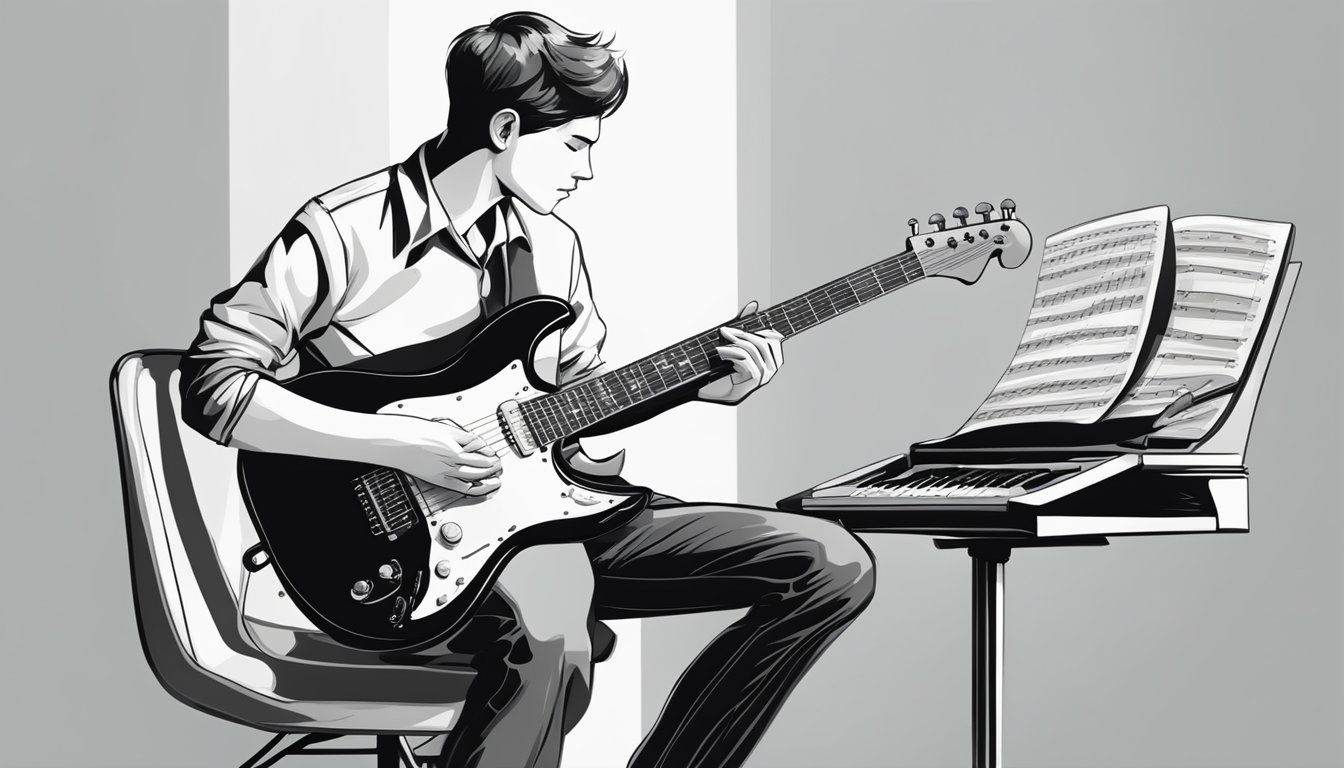Starting your journey with the electric guitar can be exciting and a bit overwhelming. Learning how to play electric guitar for beginners begins with understanding your instrument and mastering some basic skills.
Once you get the hang of the fundamentals, you’ll be playing your favorite songs in no time.

It’s important to familiarize yourself with the different parts of your electric guitar. Knowing how to hold it, where to find the right strings, and how to tune it will make a big difference in your playing.
As you practice, focus on essential chords and strumming patterns that form the foundation for almost every song out there.
With consistency and the right approach, you’ll find yourself improving quickly.
Remember, every guitarist started as a beginner, so embrace the learning process and have fun along the way!
Key Takeaways
- Get to know your electric guitar and its basic parts.
- Master essential chords and simple strumming patterns.
- Regular practice is key to becoming a better guitarist.
Getting to Know Your Electric Guitar
Knowing your electric guitar helps you play better and enjoy the experience more.
Familiarizing yourself with its parts, understanding the differences between electric and acoustic guitars, and setting up a dedicated practice space are key areas to focus on.
Parts of the Guitar
Your electric guitar has several important parts.
Here are the main ones to know:
- Body: The main part that can come in different shapes and sizes.
- Neck: This is where you place your fingers to play notes.
- Strings: Usually six in number, they create sound when played. Electric guitars often use lighter strings for easier playability.
- Pickups: These can be single coils or humbuckers that capture the strings’ vibrations and send them to the amp.
- Machine heads: These are located on the headstock and help you tune your guitar.
- Controls: Tone and volume knobs let you adjust your sound.
Getting to know these parts helps you understand how your guitar works.
Electric vs. Acoustic
While both types of guitars are fun to play, here are a few differences to keep in mind:
- Sound: Electric guitars rely on pickups and amps for sound, while acoustic guitars use their body to project sound.
- Strings: Electric guitars generally have lighter strings, making them easier on your fingers.
- Neck Width: Electric guitar necks are usually narrower, so they can be easier to play for some people.
- Versatility: Electric guitars offer more effects and tones when used with a guitar amp, letting you explore various music styles.
Choosing between an acoustic or electric depends on your musical goals and preferences.
Setting Up Your Practice Space
Creating a comfortable practice space is essential.
Here’s how to set it up:
- Quiet Area: Find a spot where you can focus without distractions.
- Good Lighting: Make sure the area is well-lit to read tabs or sheet music easily.
- Music Stand: Use a stand or a table to keep your music accessible.
- Guitar Gear: Keep your guitar, tuner, strings, and strap handy. Have a guitar amp nearby if you’re using an electric guitar.
A dedicated space sets the mood for effective practice and helps you develop your skills faster.
Fundamentals of Playing
When you start playing electric guitar, it’s important to grasp some key concepts. Knowing how to hold your guitar properly, tune it right, and understand the fretboard will set a solid foundation for your musical journey.
Let’s break down these essentials.
Holding the Guitar
To hold your guitar correctly, sit or stand comfortably.
Make sure the body of the guitar rests against your right leg if you’re right-handed.
Your right arm should drape over the body to reach the strings easily.
Your left hand will move along the neck, so keep your wrist relaxed to avoid strain.
Position your fingers on the fretboard with a light touch.
Use your fingertips to press down on the strings.
This helps create a clean sound without buzzing.
Try holding it in a way that’s natural for you, making adjustments as needed.
As you practice, you will find what feels best and allows for smooth movements.
Tuning Your Guitar
Before you start playing, learning how to tune your guitar is crucial.
A well-tuned guitar sounds better and makes playing enjoyable.
The standard tuning for your six strings is E-A-D-G-B-e, from the thickest to the thinnest string.
You can use a digital tuner, which is precise and user-friendly.
Alternatively, try tuning by ear, matching each string to a reference pitch.
Regularly check your tuning, as it can slip, especially with new strings or changes in temperature.
Understanding the Fretboard
The fretboard is where the magic happens.
It’s essential to know the layout.
Each fret corresponds to a note, and the musical alphabet consists of seven notes: A, B, C, D, E, F, and G.
Practice identifying these notes on the fretboard.
Start with the open strings and work your way up.
Use memory tricks, like seeing patterns or shapes, to help you remember where each note is located.
Understanding your fretboard will aid your music theory knowledge and help when playing scales or melodies.
Chords and Strumming
Getting comfortable with chords and strumming is key to playing electric guitar.
These skills allow you to play countless songs and improve your overall playing.
Let’s break it down into basic chord shapes, strumming patterns, and how to switch between chords.
Basic Chord Shapes
When starting out, you’ll want to learn some basic chord shapes.
These are the foundation of many songs.
The most common open chords are G, E, C, D, and A.
- E Major Chord: Place your fingers on the 1st fret of the G string, 2nd fret of the A string, and 2nd fret of the D string.
- E Minor Chord: Simply remove your index finger from the E major chord.
Using chord charts can make this process easier.
You can find diagrams showing finger placement, which helps with learning how to hold your pick and position your fingers right.
Practice switching between these chords to build your muscle memory.
Strumming Patterns and Techniques
Once you have some chords down, it’s time to focus on strumming.
Good strumming patterns are essential for rhythm.
Start with simple downstrokes, then mix in upstrokes.
Here are a few beginner patterns you can try:
- Basic Downstrokes: Strum down on every beat.
- Down-Up Strumming: Alternate between down and up on each beat.
- D-D-U-U-D-D-U: This is a great pattern for many songs.
Pay attention to how you hold your pick.
A relaxed grip will help you strum more smoothly.
Experiment with different patterns to see what you like and what fits with the songs you want to play.
Switching Between Chords
Switching between chords smoothly takes practice.
Start slowly so you can think about finger placement and ensure each note rings clearly.
- Focus on One Chord Change at a Time: For example, transition from E to A.
- Use Your Ears: Listen for whether each chord sounds right.
- Practice with a Metronome: This helps improve your timing.
Once you feel comfortable, challenge yourself with combinations like G to C or E minor to D. With consistent practice, you’ll find that switching chords becomes more natural, making your playing sound more fluid.
Practicing and Progressing

To improve your skills on the electric guitar, it’s important to practice effectively and track your progress.
This section covers useful techniques such as scales, creating consistent routines, and finding helpful resources.
Scales and Soloing
Learning scales is a key part of playing the guitar.
The major scale and minor scale are essential building blocks.
They help you understand how notes fit together and make it easier to create your own solos.
Start with the C major scale and the A minor scale.
Use a guitar pick for clear notes.
Play each scale slowly, then gradually increase your speed.
This will improve your finger dexterity and help you develop a unique sound.
You can also try practicing scales with a capo.
This will allow you to play in different keys while using the same finger patterns.
Mixing scales into your practice will make your playing more fluid and creative.
Developing Consistent Practice Routines
Creating a practice schedule is crucial for improvement.
Aim for at least 30 minutes a day.
Break this time into short sessions focusing on different skills like chords, strumming, or scales.
For example, dedicate 10 minutes to practicing major and minor chords.
Use the next 10 minutes to work on scales.
In the final 10 minutes, play along with your favorite rock music or watch online guitar lessons for inspiration.
Consistency is key.
Try practicing at the same time every day.
This helps establish a routine, making it easier for you to commit to regular practice.
Tips and Resources for Beginners
Finding good resources can make a big difference in your learning journey.
Websites like Guitar Tricks offer step-by-step video lessons.
They break down everything from chords to soloing, making it easier for you to follow.
YouTube also has great channels for beginner lessons.
Consider looking for videos that focus on playing chords and understanding guitar sound.
Don’t forget to join online forums or local groups.
Connecting with other learners can motivate you.
Share tips, tricks, and even song ideas to help each other progress.
Frequently Asked Questions
Learning electric guitar can be a fun and rewarding journey.
Here are some common questions that beginners often have when starting out.
Many newcomers wonder about the best techniques for mastering chords and strumming patterns.
Additionally, they might search for specific songs to motivate their practice, such as how to play creep on guitar.
With the right resources and dedication, beginners can quickly progress and discover their unique style while enjoying the process.
What’s the first step to learning electric guitar on my own?
The first step is to get familiar with your guitar. Learn how to hold it properly, and get to know the parts like the neck and body.
Once you’re comfy, start by tuning your guitar.
You can use a tuner or a tuning app for this.
Are there any beginner-friendly chords I should start with on electric guitar?
Yes! Start with easy chords like G, C, D, E minor, and A minor.
These chords are used in many songs and will help you build a solid foundation.
Practice switching between them to get your fingers moving smoothly.
Can you suggest good resources for self-taught electric guitar lessons?
Definitely! Websites like National Guitar Academy offer great step-by-step guides.
YouTube is also full of helpful tutorial videos.
Find a channel that matches your learning style and stick with it.
What are some tips for practicing electric guitar at home for a total newbie?
Set aside a regular time each day to practice.
Start with short sessions of 15-30 minutes.
Focus on one thing at a time, like learning a chord or strumming pattern.
You can also use a metronome to keep your timing steady.
Is it realistic to pick up electric guitar as my first instrument?
Absolutely! Many people start with electric guitar.
It’s forgiving and fun, especially if you enjoy rock or pop music.
Just be patient with yourself and enjoy the learning process.
How do I maintain my electric guitar when I’m just starting out?
Keep your guitar clean by wiping it down after each use.
Check for any loose strings and keep your guitar in a safe place.
Consider changing the strings every few weeks to keep your sound fresh.

